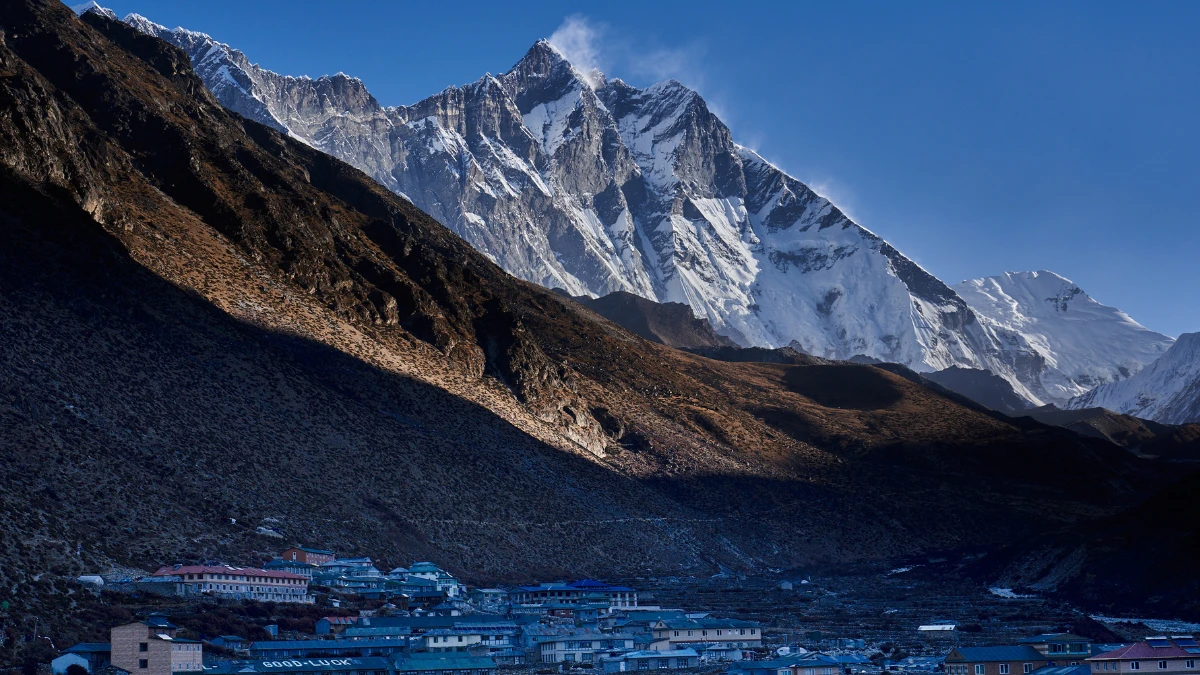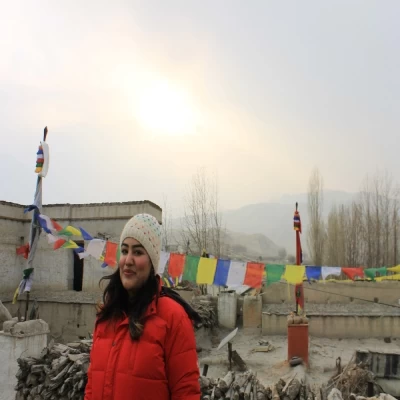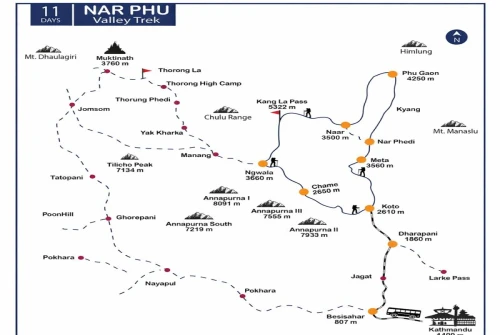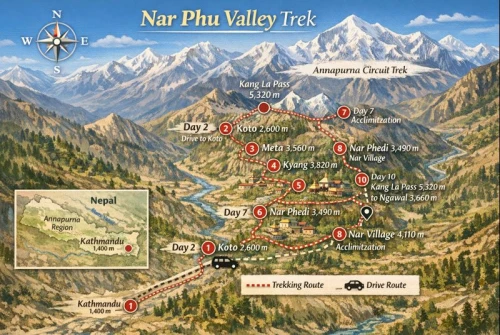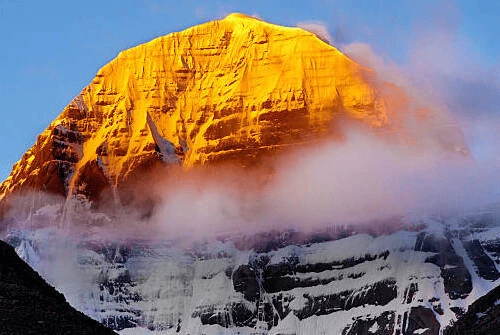Overview
The Everest Base Camp trek in autumn is one of those life-changing journeys that blends adventure, culture, and natural beauty most perfectly. Autumn, which spans from September to November in Nepal, is widely regarded as the best season for trekking in the Himalayas. With stable weather, crystal-clear skies, and comfortable temperatures, it is the most sought-after time for adventurers from around the globe.
When we step onto the trail in autumn, the Himalayas greet us with unparalleled clarity. Each sunrise reveals golden peaks, and every sunset paints the mountains with fiery hues. The lush forests, dotted with rhododendrons and pine, create a vibrant backdrop as we make our way toward the base of the world’s highest mountain. The atmosphere feels magical, almost as if nature itself opens its arms wider during this season.
Apart from the breathtaking scenery, autumn also offers a cultural feast. Nepal celebrates major festivals like Dashain and Tihar during this period, which gives trekkers a unique chance to experience local traditions along the way. The warmth of the people, combined with the festive spirit, adds a cultural depth to the trekking journey. In this detailed guide, we’ll explore why autumn is considered the best season for the Everest Base Camp trek, what to expect on the trail, and how to prepare for an unforgettable adventure.
Why Choose Autumn for the Everest Base Camp Trek?
When planning the Everest Base Camp trek, one of the first questions that comes to mind is: Which season is the best? For many seasoned trekkers, the answer is simple – autumn. This season provides the perfect balance of weather, visibility, and cultural vibrance, making it the most rewarding time to set foot on the legendary trail.
One of the main reasons autumn stands out is the stability of the weather. Unlike the unpredictable rains of summer or the freezing temperatures of winter, autumn brings clear skies and moderate conditions. This means trekkers can enjoy consistent walking days without worrying about sudden downpours or heavy snow blocking the paths. The air is crisp and refreshing, giving every step a sense of energy and comfort.
Another advantage of trekking in autumn is the breathtaking visibility. The monsoon rains of summer wash away dust and pollution, leaving behind a crystal-clear atmosphere. As we trek, we are greeted by panoramic views of Everest, Lhotse, Nuptse, Ama Dablam, and other iconic peaks, almost as if they’ve been polished for our arrival. For photographers, this season is a dream, offering postcard-perfect frames at every turn.
Lastly, autumn is also the peak trekking season in Nepal, and while that means more trekkers on the trail, it also brings a special kind of energy. The villages come alive with travelers from across the globe, sharing stories, laughter, and camaraderie. Tea houses are well-prepared, supplies are abundant, and the overall trekking experience feels more vibrant and organized. It’s like walking into a festival of adventure where everyone shares the same dream – to stand at the base of Mount Everest.
What Makes Autumn Weather Perfect for Trekking?
The weather plays a huge role in the success of any Himalayan trek, and autumn provides the most reliable conditions for Everest Base Camp. During this season, days are pleasantly warm, skies are crystal clear, and rainfall is minimal, creating the perfect environment for long trekking days. Unlike the harsh cold of winter or the muddy trails of monsoon, autumn strikes the right balance for both beginners and experienced trekkers.
Daytime temperatures during autumn are ideal for hiking, usually ranging between 12°C to 18°C (54°F to 64°F) at lower altitudes. Even at higher altitudes like Gorak Shep or Base Camp, the temperatures remain manageable during the day, allowing us to trek comfortably with just a few layers. Mornings and evenings can get chilly, often dropping close to freezing, but this only makes the cozy tea houses and warm meals even more rewarding after a long day on the trail.
Another factor that makes autumn weather perfect is its stability. Flight cancellations to Lukla are far less frequent in autumn compared to other seasons. Clear skies mean that the stunning Himalayan views are uninterrupted, and we can enjoy each day without the stress of unpredictable storms or snowfalls. For trekkers who want peace of mind and smooth logistics, autumn is the most reliable choice.
Finally, autumn weather enhances the overall trekking experience. The crisp air makes each breath feel fresher as we climb higher, and the vibrant sunlight highlights every ridge, glacier, and snow-dusted peak. Walking through this season feels like nature is putting on its best show, a combination of comfort, safety, and unmatched beauty.
When Exactly is the Autumn Trekking Season in Nepal?
Autumn in Nepal stretches from September to November, and each month brings its own flavor to the Everest Base Camp trek. While all three months are great for trekking, the experiences vary slightly depending on weather, trail conditions, and the number of trekkers on the route.
September – The Beginning of Autumn
September marks the start of the autumn trekking season, just after the monsoon rains retreat. Early in the month, trails may still be damp and lush from the rainfall, but this adds a refreshing green vibrance to the landscapes. Waterfalls, rivers, and streams flow at their fullest, making the journey feel alive with natural energy. By mid-September, the skies start clearing up, and visibility improves dramatically. We begin to see the mighty peaks standing tall without clouds veiling them. It’s also less crowded compared to October, so those seeking a quieter trail often prefer trekking in September. However, trekkers should be prepared for occasional rain showers early in the month.
October – The Peak of Trekking Season
October is widely regarded as the best month for the Everest Base Camp trek. The weather is at its most stable, with sunny days, clear skies, and comfortable trekking temperatures. This is the time when the Himalayan views are at their absolute best – snow-capped mountains appear in sharp detail, and the blue skies provide the perfect backdrop for photography. The trails in October are bustling with trekkers from around the world, which creates a lively and energetic atmosphere. Tea houses are full of adventurers sharing stories by the fireplace, and every village along the way feels vibrant. However, because it is the busiest month, accommodations can fill up quickly, making advance booking a smart choice.
November – The Golden End of Autumn
November is the last month of autumn, and it brings slightly colder weather, especially at higher altitudes. The skies remain beautifully clear, and the mountain views are still spectacular. The trails start thinning out compared to October, which offers a more peaceful trekking experience while still enjoying excellent conditions. What makes November special is the golden landscapes. The forests and valleys begin to take on autumn colors, with golden-brown shades that glow under the crisp sunlight. This gives the trek a distinct charm, as if nature is preparing for winter but still holding on to its warmth. For trekkers who want a balance of good weather and fewer crowds, November is the perfect choice.
What Scenery to Expect During Autumn?
The Everest Base Camp trek in autumn is nothing short of a visual masterpiece. Every step feels like walking through a living postcard, where nature unfolds its beauty in layers. From the lush valleys of the lower Khumbu to the icy glaciers near Base Camp, the scenery during this season is unmatched. The biggest highlight, of course, is the clear mountain views. Autumn skies are usually free of haze, giving trekkers uninterrupted panoramas of some of the world’s tallest peaks. Everest, Lhotse, Nuptse, and Ama Dablam rise sharply into the sky, their snow-draped ridges glistening in the sun. Even lesser-known peaks look strikingly majestic, making us pause often to soak in the sheer grandeur of the Himalayas.
Beyond the mountains, the landscapes along the trail transform into a painter’s dream. The valleys are fresh and green after the monsoon, with terraced fields shining in different shades of gold and emerald. Pine forests, rhododendron groves, and yak pastures add layers of color and texture. By November, the trees begin to take on warm autumn hues, creating a golden-brown contrast against the snowy summits.
Adding to the natural beauty is the cultural vibrancy of autumn festivals. This season coincides with Nepal’s biggest celebrations, Dashain and Tihar. Villages along the trail often display prayer flags, decorated homes, and festive gatherings. Trekkers not only witness the landscapes but also get a taste of Himalayan traditions, where culture and nature blend seamlessly. Simply put, the Everest Base Camp trek in autumn offers a full spectrum of beauty, crystal peaks, colorful valleys, and lively local culture, making the journey as rewarding as the destination itself.
What is the Difficulty Level of the EBC Trek in Autumn?
The Everest Base Camp trek is often described as a moderate to challenging trek, and autumn makes it slightly easier compared to other seasons. The stable weather and dry trails mean that trekkers don’t have to deal with heavy snow or slippery paths, which significantly reduces the physical strain. However, the altitude and long walking days still make it a demanding adventure that requires preparation.
From a trail perspective, the paths are generally well-defined and dry during autumn. The terrain varies from gentle climbs through forests and villages to steeper ascents near places like Namche Bazaar and Tengboche. The higher we go, the thinner the air becomes, making even moderate hikes feel more tiring. This is why proper pacing, hydration, and acclimatization are essential for success.
The altitude challenge is the toughest part of the EBC trek. Reaching Base Camp at 5,364 meters (17,598 ft) and Kala Patthar at 5,545 meters (18,192 ft) means our bodies need time to adjust. Even in autumn, when conditions are favorable, altitude sickness can affect anyone, regardless of fitness level. Trekkers should be ready for gradual climbs, rest days for acclimatization, and listening closely to their body’s signals.
In terms of fitness, autumn offers an advantage because the comfortable temperatures reduce fatigue compared to trekking in extreme cold or heat. That said, trekkers should be in good physical shape, able to walk 5–7 hours a day with a backpack. Regular cardio exercises, strength training, and practice hikes before the trip can make a big difference. Overall, the Everest Base Camp trek in autumn is manageable for most people with determination, preparation, and the right mindset. It’s not a technical climb, but it is a test of endurance and mental strength. With the supportive autumn weather, many trekkers find this season to be the perfect balance of challenge and reward.
What is the Accommodation Like During Autumn?
One of the key elements that makes the Everest Base Camp trek comfortable in autumn is the availability and quality of accommodation along the trail. The Khumbu region is dotted with tea houses, lodges, and guesthouses that cater specifically to trekkers, offering warmth, food, and a cozy place to rest after long days on the trail.
Tea houses are the most common form of lodging, ranging from basic to moderately comfortable. Most of them provide twin or triple rooms with blankets and mattresses, shared bathrooms, and simple heating options like small stoves. In autumn, these tea houses are fully operational, as it’s the peak trekking season. Unlike winter, when some lodges may close due to harsh weather, autumn ensures that almost every stop along the trail, from Namche Bazaar to Gorak Shep, has open and ready accommodations. Facilities in tea houses have also improved significantly over the years. Many lodges now offer hot showers, charging points for devices, Wi-Fi in popular villages, and even small shops to buy snacks or trekking gear. In October, when the trail is busiest, accommodations can fill up quickly, so booking in advance, or at least starting early in the day to secure a room, is highly recommended. By November, the crowd thins slightly, giving trekkers a better chance of finding available rooms without stress.
Finally, the experience of staying in tea houses adds to the charm of the trek. Beyond just rest, they provide a social atmosphere where trekkers from around the world meet, share stories, and enjoy meals together. In autumn, the evenings in these lodges are particularly lively, with the warmth of fires and conversations contrasting against the crisp Himalayan nights outside. It’s an experience that combines comfort, culture, and camaraderie—making every stop on the EBC trek more memorable.
What to Eat on the Everest Base Camp Trek in Autumn?
Food is not just fuel on the Everest Base Camp trek, it’s part of the adventure. Autumn makes mealtimes especially enjoyable because the weather is stable, and the tea houses along the trail are fully stocked with a variety of options to satisfy trekkers from around the globe.
Local Nepalese Cuisine
The most common meals on the trail are traditional Nepalese dishes. Dal Bhat (lentil soup with rice and vegetables) is the staple and provides a balanced mix of protein and carbs for sustained energy. Momos (Tibetan-style dumplings) are another popular choice, often filled with vegetables, chicken, or buffalo meat, and served with spicy sauces that warm you up after a chilly day on the trail. Other options like Thukpa (noodle soup) and vegetable curries are also widely available, giving trekkers plenty of variety.
Western-Style Options
For those craving familiarity, tea houses in autumn usually offer Western meals as well. Pasta, omelets, pancakes, and even pizza are common in popular villages like Namche Bazaar and Dingboche. This combination of local and international cuisine ensures that trekkers can maintain their energy while also enjoying comfort foods that remind them of home.
Staying Hydrated
Hydration is crucial at high altitudes, and autumn provides ideal conditions to drink plenty of water without excessive sweating. Many lodges offer boiled or filtered water, but it’s wise to carry a reusable water bottle and purification tablets. Warm drinks like tea, coffee, and hot chocolate are also excellent choices to stay hydrated while keeping warm during chilly evenings.
Eating in autumn is not just about nutrition; it’s an experience in itself. The tea houses, with their cozy interiors and panoramic views, turn every meal into a moment of relaxation and camaraderie. Sharing a hot plate of Dal Bhat or a cup of tea with fellow trekkers against the backdrop of snow-capped peaks makes the journey even more memorable.
Where Does the Everest Base Camp Trek Start?
The Everest Base Camp trek officially begins with one of the most thrilling experiences in Nepal – the flight to Lukla. This short, 30–35-minute journey from Kathmandu (or Ramechhap during peak season) offers jaw-dropping views of the Himalayas even before we set foot on the trail. Lukla Airport, often called one of the most adventurous airstrips in the world, sits at 2,860 meters (9,383 ft) and instantly immerses trekkers into the heart of the Khumbu region. In autumn, flights are more reliable thanks to clear skies, making it the most stress-free time to travel.
From Lukla, the trek officially begins with a descent into lush valleys and a walk along the Dudh Koshi River. The first few days are filled with vibrant scenery—suspension bridges draped with prayer flags, small Sherpa villages, and fields where yaks graze peacefully. This part of the journey is especially beautiful in autumn, as the trails are alive with greenery and the air is fresh from the retreating monsoon.
One of the biggest milestones early in the trek is reaching Namche Bazaar, the bustling trading hub of the Khumbu region. At 3,440 meters (11,286 ft), Namche is not only a place to rest and acclimatize but also a cultural highlight. The town buzzes with trekkers, shops, bakeries, and markets. In autumn, Namche is especially lively, with trekkers from all over the world gathering here before heading deeper into the mountains. The clear skies also make it the perfect spot to catch the first grand views of Everest itself.
From Namche onwards, the trail continues toward Tengboche, Dingboche, and eventually Everest Base Camp. Each step feels more connected to the Himalayas, and autumn ensures that the journey unfolds smoothly with stable weather and breathtaking scenery. Starting in Lukla and passing through Namche is more than just the beginning—it sets the rhythm of the trek, blending adventure with cultural encounters right from day one.
How Crowded are the Trails in Autumn?
Autumnis the peak trekking season in Nepal, and this means the Everest trekking trails can get quite busy. Trekkers from all over the world flock to the Khumbu region to enjoy the perfect weather and stunning views, creating a lively, energetic atmosphere along the route. The busiest months are October and early November, when tea houses, villages, and popular viewpoints like Namche Bazaar, Tengboche, and Dingboche are filled with trekkers. Lines for hot showers, meals, and even rooms in lodges are common during this period. While some may see this as a downside, it also offers a sense of community. Sharing the trail with fellow adventurers often leads to new friendships, shared stories, and tips for the journey ahead.
Some sections of the trail, like the ascent to EBC and Kala Patthar, can become crowded during mid-morning hours. To avoid congestion, experienced trekkers often start early in the morning or take short breaks at less popular spots along the trail. This allows for a more peaceful and personal experience while still enjoying the stunning scenery. Even with the crowds, autumn is ideal for trekking because all facilities are fully operational, and the social energy adds to the adventure rather than taking away from it. Being prepared for the presence of fellow trekkers and planning can help make the journey smooth and enjoyable, without feeling rushed or overwhelmed.
How Much Does the Everest Base Camp Trek Cost in Autumn?
The cost of the Everest trek in autumn can vary widely depending on whether you go independently or with a guided package, but autumn generally falls into the higher cost bracket due to peak-season demand. Here’s a detailed breakdown of what to expect.
Permits and Entry Fees
Every trekker needs to secure the Sagarmatha National Park Permit (approximately $30 USD) and the Khumbu Pasang Lhamu Rural Municipality Permit (around $20 USD). Additionally, a trekker’s TIMS card costs about $10–$20 USD. These permits are mandatory and help preserve the park while supporting local communities.
Accommodation and Meals
Tea house accommodation costs more during autumn due to high demand. Rooms typically range from $5 to $15 USD per night, depending on location and facilities. Meals cost between $5–$10 USD for a main course, with hot drinks priced at $2–$3 USD. Staying at higher-altitude stops like Gorak Shep is slightly more expensive, but the comfort and warmth make it worthwhile.
Guide, Porter, and Trekking Agencies
Hiring a guide costs approximately $25–$30 USD per day, while a porter costs around $20–$25 USD per day. Many trekkers prefer a guide for safety, navigation, and cultural insights, especially during autumn when trails are busy. Trekking agencies often offer packages ranging from $1,200 to $2,000 USD per person, which include accommodation, meals, permits, and support staff.
Extra Costs
Other costs may include flights to Lukla ($160–$200 USD one way), gear rental, and personal items like snacks or souvenirs. It’s wise to budget an extra 10–15% for unforeseen expenses, especially in peak-season autumn when services are in high demand. In summary, the Everest Base Camp trek in autumn is an investment, but it ensures optimal weather, full facilities, and an unforgettable experience. Being prepared financially allows trekkers to focus on the journey without unnecessary stress.
How to Prepare for the EBC Trek in Autumn?
Preparation is key to making the Everest Base Camp trek in autumn both safe and enjoyable. Even though the season offers ideal weather, the trek remains physically demanding and mentally challenging. Proper planning ensures that we can fully savor the adventure rather than struggle along the trail.
Physical Training
Physical fitness is essential for a successful trek. Trekkers should focus on cardiovascular endurance, leg strength, and core stability. Activities like hiking with a backpack, running, cycling, and stair climbing mimic trekking conditions and build stamina. Strength training for thighs, calves, and back muscles helps prevent injuries, while flexibility exercises like yoga improve balance and recovery. Starting at least 2–3 months before the trek provides ample time to condition the body.
Mental Preparation
The Everest Base Camp trek is not just a physical challenge; it’s a mental journey as well. Long walking days, high altitudes, and limited connectivity can test patience and resilience. Practicing mindfulness, visualization techniques, and setting realistic expectations can help trekkers stay motivated. Reading trekking blogs, watching documentaries, or talking to experienced trekkers also builds confidence and reduces anxiety.
Altitude Readiness
Altitude sickness is a major consideration, even in the stable autumn season. Acclimatization is critical: plan rest days in key villages like Namche Bazaar and Dingboche, and follow the principle of gradual ascent. Staying hydrated, avoiding alcohol, and monitoring symptoms closely can prevent serious issues. Some trekkers carry medications like Diamox as a precaution, but consulting a doctor before the trek is essential.
Gear and Logistics
Preparation also involves checking gear, clothing, and permits ahead of time. Autumn’s stable weather allows lighter packing compared to winter, but ensuring that all essentials are ready—boots, layers, sleeping bags, trekking poles—makes the trek smoother. Booking flights, tea house stays, and guides in advance is highly recommended due to peak-season demand.
With the right preparation, the Everest Base Camp trek in autumn becomes a journey of confidence and enjoyment, letting trekkers focus on breathtaking scenery, cultural immersion, and personal achievement rather than worrying about challenges.
What to Pack for the Autumn Everest Base Camp Trek?
Packing for the Everest Base Camp trek in autumn requires a balance between warmth, comfort, and practicality. The stable weather makes layering easier, but altitude and fluctuating temperatures still demand careful preparation. Having the right gear ensures safety, comfort, and an enjoyable trekking experience.
Essential Clothing Layers
Layering is key to staying comfortable on the trail. Start with moisture-wicking base layers, followed by insulating mid-layers like fleece jackets, and top it with a waterproof and windproof outer shell. Lightweight trekking pants for daytime walks and thermal leggings for colder mornings or nights are ideal. Don’t forget a warm hat, gloves, and a scarf or buff, as temperatures can drop sharply, especially above 4,000 meters.
Trekking Gear
Good trekking boots are non-negotiable – ideally sturdy, waterproof, and well-broken-in. Trekking poles can reduce strain on knees during steep ascents and descents. A comfortable daypack with a rain cover, a headlamp, sunglasses with UV protection, and a reusable water bottle are also essential. For higher altitudes, a sleeping bag rated for -10°C to -15°C is recommended, especially if you plan to stay in more basic lodges.
Personal Items and Extras
Don’t overlook personal essentials like sunscreen, lip balm with SPF, a first-aid kit, trekking permits, and travel documents. Hand sanitizer, wet wipes, and extra batteries or power banks are very useful on the trail. In autumn, the trail is relatively dry, but carrying a light rain jacket can be a lifesaver if unexpected showers occur.
Autumn makes trekking more enjoyable because the gear you carry won’t be weighed down by snow or heavy rain, allowing you to move freely and focus on the views. Packing smart ensures that every day of the trek feels smooth, safe, and comfortable while letting you fully immerse yourself in the adventure
